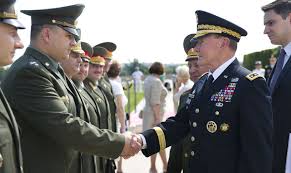Russia-US Security Dialogue Looming: Time to Address a Broader Security Agenda

A lot of people close to the US president wanted to prevent it at any cost but Donald Trump congratulated President Putin anyway and had a phone conversation with him. The US president said that the two would meet “in the not too distant future.” Preventing an arms race is one issue on the agenda. Donald Trump knew the move would bring forth a tempest but he did it anyway. The president considered the relationship with Moscow to be important enough to defy his numerous opponents. Serbia has already offered to host a summit.
Right after the two presidents’ conversation, the Russian and American chiefs of staff discussed Syria. What’s even more important is that they have agreed to more military-to-military contacts in the future. Why has it suddenly become so important for Washington to launch a dialog on defense issues? The answer was provided by General John E. Hyten, the Commander of US Strategic Command, who admitted in the Senate that the US is defenseless in the face of the threat from hypersonic weapons. This realization came right after Russian President Vladimir Putin revealed his recent information about the new systems capable of hypervelocity flight that are currently being tested and are soon to be operational.
The US is a great military power but it’s not strong enough to force everyone to dance to its tune. Its defense programs suffer from serious shortcomings. The current arms-control system is in crisis. New challenges keep cropping up. They should be incorporated into the international security agenda but that’s not happening.
The looming hypersonic race is a burning issue that still needs to be addressed. It’s a domain in which the US is lagging behind Russia. When the Russian president announced those breakthroughs in military technology, his revelations were met with some skepticism in the West. But the ensuing events proved him right. Vladimir Putin pulled it off, making hotheads come to their senses and realize the need for talks to address the security challenges. Washington needs this dialog more than Moscow does.
So, the Americans’ coveted leadership in military technology has turned out to be a pipe dream. But their furtive steps to bring NATO right to Russia’s doorstep are not. The most interesting things often fall off the radar.
Moldova is to planning to phase out its draft in order to have a professional military. This month, Moldova, Georgia, and Ukraine formed an anti-Russia alliance. Moving to an all-volunteer force is in keeping with the political goals of this group and is seen as an important step on the path to NATO membership. That reform is scheduled to begin this fall. This is a very costly endeavor, especially when one is talking about the poorest country in Europe. Chisinau cannot afford it. It will be fully dependent on assistance from Romania and other NATO states.
Moldova’s process of embracing the bloc has accelerated recently. A joint Romanian-Moldovan task force equipped and trained in accordance with NATO standards is on its way. That step was agreed on in February. According to the military cooperation agreement signed by Chisinau and Bucharest in 2012 and ratified by the Moldovan parliament in 2013, Romanian troops and police forces enjoy freedom of movement on Moldovan territory. In other words, a NATO member has a free hand in Moldova, although the region of Transnistria, where Russian peacekeepers are stationed, is part of that country. This is a real hornet’s nest and the problem remains unaddressed.
The fact that Poland has shifted its best military forces, including its most modern tanks, eastward has not gone unnoticed in Russia. The country will receive 70 AGM-158B JASSM-ER long-range air-to-surface missiles from the US by 2020 or a bit earlier. With an operational range of roughly 1,000 km, this stealth weapon boasting a penetrating warhead can hit infrastructure deep inside Russia. One does not have to be a military expert to realize that the JASSM-ER’s prime mission is to knock out Russian Iskander short-range missiles deployed in the Kaliningrad region in a first strike.
The small Polish town of Powidz is to become a NATO hub for the Baltics and Northern Europe. Construction is underway to build a storage facility for a brigade’s worth of military hardware and personnel. The US Aegis Ashore BMD system will be operational in Poland this year. This is a highly destabilizing weapon that will become a target for a first strike by the Russian military.
Nor has Russia forgotten about the 300 US Marines stationed in Norway, or the construction of a sophisticated new radar system known as Globus 3 in the Norwegian Arctic archipelago of Svalbard. This is a violation of international law, as Svalbard was supposed to be demilitarized under a 1925 treaty. The facility there is an element of NATO’s ballistic missile defense (BMD) system. The joint US-Norwegian radar station is viewed by Moscow as a clear provocation. Norway is to be provided with over 50 US F-35 stealth fighters in 2019, enabling it to strike Russian territory. The F-35 is a nuclear-capable plane.
All these moves are being closely watched by the Russian military. Even if new weapons are incorporated into the bilateral arms-control agenda, the efforts to create the potential for a first strike near Russia’s borders are certainly not something Moscow can turn a blind eye toward. This does not create the right environment for a security dialog between Moscow and Washington. Everything is connected.
What Russia and the US really need is not just talks about curbing super weapons, but also negotiations addressing a much broader security agenda.
*
Alex Gorka is a defense and diplomatic analyst.
Featured image is from the author.

